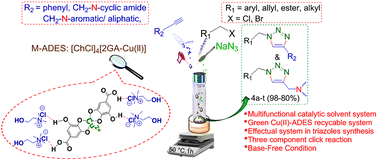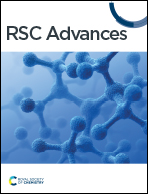Novel Cu(ii) acidic deep eutectic solvent as an efficient and green multifunctional catalytic solvent system in base-free conditions to synthesize 1,4-disubstituted 1,2,3-triazoles†
Abstract
A novel green Cu(II)-acidic deep eutectic solvent (Cu(II)-ADES) bearing copper salt, choline chloride, and gallic acid ([ChCl]4[2GA-Cu(II)]) was synthesized and thoroughly specified by physicochemical approaches such as FT-IR, EDX, XRD, Mapping, ICP, and UV-Vis analyses and physicochemical properties. After the detection of authentic data, the central composite design (CCD) was utilized to accomplish the pertaining tests and develop the optimum condition, and, in the following, [ChCl]4[2GA-Cu(II)] was applied as a green multifunctional catalytic solvent system in reducing agent-free and base-free condition for the three-component click reaction from sodium azide, alkyl, allyl, ester, and benzyl halide, and terminal alkyne made from amines and caprolactam as a cyclic amide to furnish a successful new library of 1,4-disubstituted 1,2,3-triazoles with a yield of up to 98%. The Cu(II)-ADES is stable and can comfortably be recovered and reused without a considerable decline in its acting for seven cycles. This triazole synthesizing methodology is distinguished via its atom economy, operational facility, short reaction times, diverse substrate scope, and high performance for large-scale synthesis of the desired products including: –CN and –NO2 as efficient functional groups.

- This article is part of the themed collection: 2023 RSC Advances Popular Advances Collection


 Please wait while we load your content...
Please wait while we load your content...